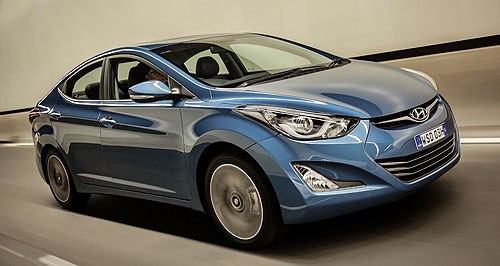New models - Hyundai - ElantraDriven: Hyundai's Series II Elantra lands Down UnderMinor update: Hyundai has refreshed its Elantra small sedan range with local suspension tuning and additional standard gear. Mid-life update for Hyundai Elantra brings suspension tweaks and slight price rise3 Jan 2014 HYUNDAI has given its Elantra small sedan a mid-life update, boosting its global top seller with more equipment, styling enhancements and locally tuned suspension. The mechanical and cosmetic improvements to the 2014 Series II Elantra bring a modest price rise on all three variants, with the base Active manual up $400, to $20,990 plus on-road costs (the automatic is a $2200 option), while the mid-spec Elite and flagship Premium are both up by $1000 each for a new price of $26,790 and $30,190 respectively. Elantra pricing now mimics equivalent variants of the i30 hatch and is in the vicinity of the outgoing Mazda3 that kicks off from $20,330 (plus on-roads) for the Neo, to $30,990 for the SP20 SkyActiv Luxury. The South Korean car-maker's global best seller – 8.77 million of the compact sedans have been sold since its launch in 1989 – gets a new chrome grille, fog-lights for all variants and newly designed alloy wheels on mid- and top-spec models. New front and rear bumpers add 20mm to Elantra’s length (4550mm), while redesigned headlights, a new belt-line moulding and a black rear diffuser are also new for 2014. The cabin gains a cooled glove-box across the range, plus sat-nav and a reversing camera replacing the old electrochromatic rear-view mirror camera on Elite and Premium variants. Hyundai has addressed negative feedback about the location of the front air vents on the 2011 iteration by shifting them further up the centre stack to improve the direction of air flow. Hyundai Australia’s Product Planning and Engineering team has revised the suspension after testing 28 combinations on urban, country, rough dirt, gravel and corrugated roads. The 22mm stabiliser bar is down from 23mm, which Hyundai says makes for sharper turn-in, reduced understeer and better offset bump-ride compliance. Other improvements under the skin include a switch from a 16-bit to 32-bit computer processing for the Elantra's motor-driven power steering system and the inclusion of Hyundai's 'Flex Steer' system that allows the driver to choose between Comfort, Normal and Sport modes that vary the feel and feedback of the steering. The Elantra's 110kW/178Nm 1.8-litre four-cylinder petrol engine matched with either a six-speed manual or six-speed automatic remains unchanged. Fuel economy is also static with the manual recording a figure of 6.6 litres per 100 kilometres and 7.1L/100km for the auto on the combined cycle. New standard equipment on the base Active includes the cooled glove-box, stainless steel door scuff plates, rear parking sensors and cloth door inserts, while features carried over include cruise control, a five-inch touch-screen, four-speaker stereo with Bluetooth and USB/Auxiliary input, audio controls on the steering wheel, power windows and 15-inch steel wheels. On top of this, the mid-spec Elite variant gains electric folding external mirrors as standard as well as alloy-look door handles, a seven-inch touch-screen with sat-nav and three-year MapCare, a premium steering wheel, dusk-sensing headlights, rain-sensing wipers and an upgrade to 16-inch alloy wheels. The Premium variant gets air vents for rear passengers, an electric sunroof, heated front seats, electrically adjustable driver's seat, leather/leatherette upholstery, HID Xenon headlights with surrounding LED positioning lights, a dark chrome grille and 17-inch alloy wheels. The current Elantra landed in local showrooms in July 2011, proving to be a solid seller, but like many other sedans in the small car segment, it has never managed to reach the sales heights of its hatchback twin – the i30. Combined sales of the Elantra and i30 put the Korean brand in third place on the 2013 local small-car sales charts with 36,328 units (8293 Elantra and 28,035 i30) sold to the end of November, behind the 2011 and 2012 winner Mazda3 (38,060) and Toyota’s Corolla that looks set to take the crown this year, 39,794 units. On the safety front, the Elantra carries a five-star ANCAP crash safety rating, thanks to six airbags and the usual suite of acronyms including ESC, ABS, EBD and Vehicle Stability Management. Hyundai's iCare customer care program includes three-years capped price servicing and a five-year/unlimited kilometre warranty. 2014 Hyundai Elantra pricing*
 Quick testsRead more15th of August 2013  First look: Hyundai refreshes ElantraFresh look, extra equipment for upgraded Hyundai small car but diesel a no-go for Oz29th of May 2012  First drive: Hyundai reboots top-selling i30 small carMore space and standard features to counter price rises for stylish new Hyundai i30Elantra pricingMotor industry news |
|
||||||||||



















































Facebook Twitter Instagram